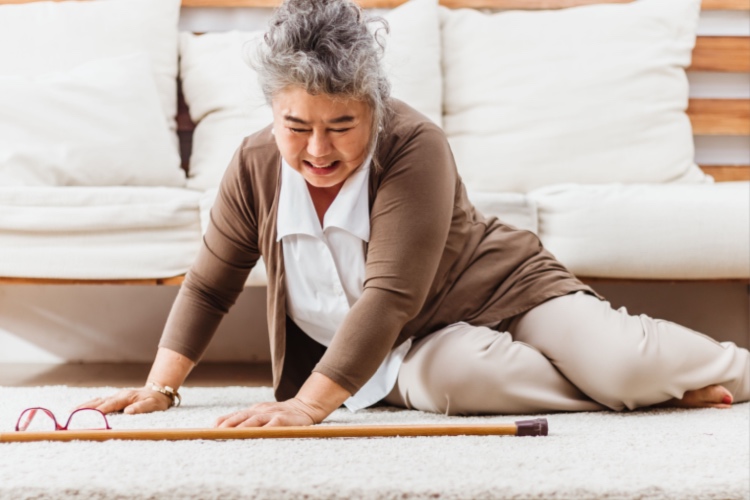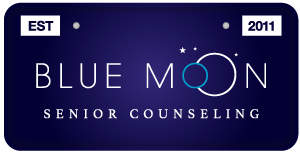
Falls in older adults pose a significant risk to their health and well-being, particularly those living alone. Each year, millions of older adults experience falls, leading to injuries, hospitalizations, and a decline in independence. Recognizing the importance of fall prevention is paramount for ensuring the safety and quality of life of older adults.
Table of Contents
- Importance of Fall Prevention for Older Adults
- Assessing Fall Risk Factors
- Implementing Preventive Measures
- Engaging Support Systems
- Empowering Independence and Confidence
- Prioritize Fall Prevention with Blue Moon Senior Counseling
- FAQs
Importance of Fall Prevention for Older Adults
According to the CDC, 36 million falls are reported among older adults each year. Preventing falls is crucial for maintaining the health, independence, and quality of life of older adults. Research also shows that one out of five falls lead to physical injuries such as fractures, head trauma, and sprains, which may result in long-term disability and reduced mobility. Additionally, the fear of falling can lead to social isolation, decreased physical activity, and a decline in mental well-being.
Living alone presents unique challenges for older adults in terms of fall prevention. Without immediate assistance or supervision, older adults may face delays in receiving help after a fall, increasing the risk of complications. Moreover, the absence of a caregiver or family member at home necessitates proactive measures to mitigate fall risks and ensure safety.
Assessing Fall Risk Factors
Understanding the various factors that contribute to fall risk among older adults is essential for developing effective prevention strategies. By identifying individual risk factors, caregivers and healthcare providers can tailor interventions to address specific needs and mitigate potential hazards.
Physical Factors
Older adults may experience physical changes that affect their balance, strength, and mobility, increasing their vulnerability to falls. Vision impairments, muscle weakness, balance issues, and chronic health conditions can all significantly impact an individual’s risk of falling.
Muscle Weakness
Muscle strength and coordination naturally decline with age, making older adults more susceptible to falls. Weakness in the lower body muscles, including the legs and hips, can impair stability and balance, increasing the likelihood of falls.
Balance Issues
Age-related changes in the vestibular system and proprioception can affect balance and postural control. Conditions such as vertigo, inner ear disorders, and neuropathy can disrupt equilibrium, leading to unsteadiness and falls.
Chronic Health Conditions
Certain medical conditions, such as arthritis, Parkinson’s disease, and stroke, can impact mobility and increase fall risk. And according to the National Institute on Aging, chronic pain, dizziness, and medication side effects further contribute to the vulnerability of older adults to falls.
Environmental Factors
The home environment plays a significant role in fall prevention for older adults living alone. Identifying and addressing environmental hazards can help create a safer living space and reduce the risk of falls. Additionally, the CDC has provided a checklist to find any hazards in your home!
Home Hazards
Unsecured rugs, cluttered pathways, and loose wires pose tripping hazards within the home environment. Furniture with sharp edges, unstable chairs, and uneven flooring can also increase the risk of falls.
Poor Lighting
Inadequate lighting, especially in dimly lit areas such as staircases, hallways, and bathrooms, impairs visibility and heightens the risk of missteps and falls. Poorly lit outdoor spaces, including entryways and pathways, further exacerbate fall hazards.
Lack of Safety Equipment
The absence of essential safety equipment, such as handrails, grab bars, and shower seats, undermines the accessibility and safety of home environments for older adults. Failure to install supportive devices in key areas increases the likelihood of falls.
Implementing Preventive Measures
Implementing preventive measures is crucial for reducing the risk of falls among older adults living alone. By proactively addressing potential hazards and adopting safety measures, older adults can create a supportive environment that promotes independence and reduces the likelihood of accidents. Some state/local governments provide education or home modification programs to help prevent falls in older adults. You can check your local health department by searching with the Eldercare Locator, or call 800-677-1116 to find your local Area Agency on USAging to see if there is a program near you.
Home Modifications
Making modifications to the home environment is an effective way to minimize fall risks for older adults. Simple changes, such as installing grab bars in bathrooms, removing tripping hazards, and improving lighting in dimly lit areas, can significantly enhance safety and accessibility. By conducting a thorough assessment of the home and implementing necessary modifications, older adults can create a safer living space that supports their independence and well-being.
Regular Exercise
Engaging in regular exercise is essential for maintaining strength, flexibility, and balance in older adults. Incorporating a variety of exercises into their routine, including strength training, balance exercises, and flexibility routines, can help older adults improve their overall fitness and reduce the risk of falls. Additionally, participating in group fitness classes or exercise programs tailored to older adults’ needs can provide social support and motivation to stay active.
Medication Management
Effective medication management is critical for minimizing the risk of falls among older adults. Older adults should regularly review their medications with healthcare providers to identify any potential side effects or interactions that may increase fall risk. Using pill organizers, setting reminders for medication doses, and adhering to prescribed dosages can help older adults manage their medications safely and reduce the likelihood of falls.
Nutrition and Hydration
Maintaining a balanced diet and staying hydrated are essential components of fall prevention for older adults. Consuming nutrient-rich foods, such as fruits, vegetables, whole grains, and lean proteins, can support bone health, muscle function, and overall well-being. Older adults should also ensure they drink an adequate amount of fluids throughout the day to prevent dehydration, which can contribute to dizziness and falls.
Engaging Support Systems
Engaging support systems is essential for older adults living alone to enhance their safety and well-being. By establishing connections, older adults can access the support and assistance they need to reduce fall risks and maintain their independence.
Community Resources
Community resources play a vital role in providing older adults with access to support services, programs, and activities that promote healthy aging and fall prevention. Senior centers offer a range of resources, including exercise classes, health screenings, and educational workshops focused on fall prevention strategies. Additionally, support groups provide older adults with opportunities to connect with peers, share experiences, and receive emotional support.
Family and Friends Involvement
Family members and friends play a crucial role in supporting older adults living alone and helping them navigate challenges related to fall prevention. Regular check-ins, phone calls, and visits provide opportunities for family members and friends to assess older adults’ well-being, identify potential fall risks, and offer assistance as needed. Additionally, family members can assist with tasks such as home maintenance, errands, and transportation, reducing the burden on older adults and enhancing their safety and independence.
Personal Emergency Response Systems (PERS)
Personal emergency response systems (PERS) offer older adults peace of mind and immediate access to assistance in the event of a fall or emergency. Wearable devices, such as necklaces or bracelets equipped with panic buttons, enable older adults to call for help with the press of a button. PERS also feature 24/7 monitoring services, which dispatch emergency responders or designated contacts to older adults’ locations when assistance is needed. By wearing PERS devices and having access to emergency support, older adults can feel confident in their ability to stay safe while living alone.
The National Council of Aging has narrowed some of the best medical alert systems.
Empowering Independence and Confidence
While fall prevention measures and support systems are essential for reducing fall risks among older adults living alone, empowering independence and confidence is equally important. By providing older adults with assistive devices, personal alarms, emergency preparedness resources, and fall detection technology, they can maintain their autonomy and peace of mind while aging in place.
Assistive Devices
Assistive devices such as mobility aids, reachers and grabbers, bed rails, and stairlifts can help older adults navigate their homes safely and independently. These devices provide support and stability, allowing older adults to perform daily tasks with greater ease and confidence.
Personal Alarms
Personal alarms, including motion sensors, door alarms, bed alarms, and smart home devices, can alert older adults and their caregivers to potential fall risks or emergencies. These devices can detect changes in movement or activity patterns and notify designated contacts or emergency responders, ensuring timely assistance and intervention.
Fall Detection Technology
Fall detection technology, such as wearable sensors, smart flooring, camera systems, and artificial intelligence solutions, can help older adults and their caregivers monitor for signs of falls and intervene promptly when needed. These innovative technologies use advanced algorithms to detect falls or changes in activity levels, providing peace of mind and reassurance to older adults and their families.
Prioritize Fall Prevention with Blue Moon Senior Counseling
Fall prevention strategies are essential for safeguarding the health, safety, and independence of older adults living alone. By understanding the various risk factors associated with falls, implementing preventive measures, engaging support systems, and empowering independence, older adults can significantly reduce their risk of falls and enhance their overall quality of life.
If you or someone you know is an older adult living alone and could benefit from personalized fall prevention strategies and support, contact Blue Moon Senior Counseling today. Our licensed therapists offer telehealth and teletherapy services specifically designed to address the needs of older adults. Together, we can create a customized plan to enhance safety, independence, and overall well-being.
FAQs
- How common are falls among older adults living alone?
Falls are a common occurrence among older adults, particularly those living alone. According to the Centers for Disease Control and Prevention (CDC), one out of four older adults experiences a fall each year, with falls being the leading cause of fatal and non-fatal injuries among older adults.
- What are some signs that an older adult may be at risk of falling?
Signs that an older adult may be at risk of falling include unsteadiness while walking, difficulty getting up from a chair or bed, frequent tripping or stumbling, and a history of previous falls. Additionally, factors such as vision impairment, muscle weakness, and certain medications can increase fall risk.
- Can falls be prevented entirely?
While it may not be possible to prevent falls entirely, there are numerous steps that older adults can take to reduce their risk of falling. These include modifying the home environment to remove hazards, engaging in regular exercise to improve strength and balance, managing medications effectively, and seeking support from healthcare providers and community resources.
- How can family members and caregivers help prevent falls for older adults living alone?
Family members and caregivers can play a crucial role in fall prevention for older adults living alone. This includes conducting home safety assessments, assisting with home modifications, encouraging regular exercise, ensuring proper medication management, and providing emotional support and encouragement.
- What should I do if an older adult experiences a fall?
If an older adult experiences a fall, it’s essential to assess their condition and seek medical attention if necessary. Even if the fall does not result in immediate injury, it’s essential to address any underlying risk factors and take steps to prevent future falls. This may involve contacting healthcare providers, conducting a home safety assessment, and implementing preventive measures.
